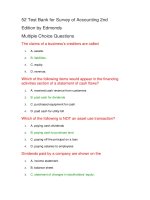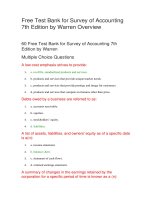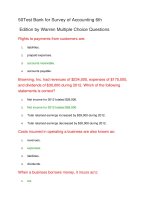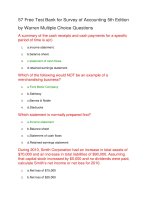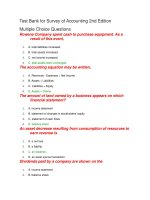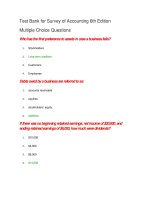Survey of accounting 6e chapter 6
Bạn đang xem bản rút gọn của tài liệu. Xem và tải ngay bản đầy đủ của tài liệu tại đây (2.49 MB, 41 trang )
Receivables and Inventory
Chapter
6
©2013 Cengage Learning. All Rights Reserved. May not be scanned, copied or duplicated, or posted to a publically accessible website, in whole or in part.
Learning Objectives
After studying this chapter, you should be able to:
•
Describe the common classifications of receivables.
•
Describe the nature of and the accounting for
uncollectible receivables.
•
Describe the direct write-off method of accounting for
uncollectible receivables.
•
Describe the allowance method of accounting for
uncollectible receivables.
©2013 Cengage Learning. All Rights Reserved. May not be scanned, copied or duplicated, or posted to a publically accessible website, in whole or in part.
Learning Objectives (continued)
After studying this chapter, you should be able to:
•
Describe the common classifications of inventories.
•
Describe three inventory cost flow assumptions and
how they impact the financial statements.
•
Compare and contrast the use of the three inventory
costing methods.
•
Describe how receivables and inventory are reported
on the financial statements.
©2013 Cengage Learning. All Rights Reserved. May not be scanned, copied or duplicated, or posted to a publically accessible website, in whole or in part.
Learning
Objective 1
Describe the common classifications of
receivables
©2013 Cengage Learning. All Rights Reserved. May not be scanned, copied or duplicated, or posted to a publically accessible website, in whole or in part.
Classifying Receivables
• Accounts Receivable
• ______________________________
• Notes Receivable
• ______________________________
• ______________________________
• Other Receivables
• ______________________________
______________________________
©2013 Cengage Learning. All Rights Reserved. May not be scanned, copied or duplicated, or posted to a publically accessible website, in whole or in part.
Accounting for Notes Receivable
Exhibit 1: Promissory Note
©2013 Cengage Learning. All Rights Reserved. May not be scanned, copied or duplicated, or posted to a publically accessible website, in whole or in part.
Learning
Objective 2
Describe the nature of and the accounting
for uncollectible receivables
©2013 Cengage Learning. All Rights Reserved. May not be scanned, copied or duplicated, or posted to a publically accessible website, in whole or in part.
Uncollectible Receivables
Q. What if a customer does not pay the balance
owed to the company?
R. Companies must recognize an _________ for
accounts that are not collectible. It is called
____________.
©2013 Cengage Learning. All Rights Reserved. May not be scanned, copied or duplicated, or posted to a publically accessible website, in whole or in part.
Bad Debt Expense
Two Methods
_______
______ _____
__________
__________
__________
©2013 Cengage Learning. All Rights Reserved. May not be scanned, copied or duplicated, or posted to a publically accessible website, in whole or in part.
Learning
Objective 3
Describe the direct write-off method of
accounting for uncollectible receivables
©2013 Cengage Learning. All Rights Reserved. May not be scanned, copied or duplicated, or posted to a publically accessible website, in whole or in part.
Direct Write-Off Method
• Bad Debt Expense is recorded and the receivable written
off when the account is determined to be worthless.
Bad debt expense
©2013 Cengage Learning. All Rights Reserved. May not be scanned, copied or duplicated, or posted to a publically accessible website, in whole or in part.
If payment is collected after the write-off
• The write-off entry is reversed and the cash
collection is recorded
Reinstate accounts receivable
Collection of accounts receivable
©2013 Cengage Learning. All Rights Reserved. May not be scanned, copied or duplicated, or posted to a publically accessible website, in whole or in part.
Learning
Objective 4
Describe the allowance method of
accounting for uncollectible receivables
©2013 Cengage Learning. All Rights Reserved. May not be scanned, copied or duplicated, or posted to a publically accessible website, in whole or in part.
Allowance Method
• Required by GAAP for companies with large amount of
accounts receivable
• Estimates the accounts receivable that will not be
collected and records bad debt expense for this estimate
at the end of each period using an allowance account
©2013 Cengage Learning. All Rights Reserved. May not be scanned, copied or duplicated, or posted to a publically accessible website, in whole or in part.
Estimate of Uncollectible
Accounts Receivable: $30,000
• If the total accounts receivable balance is $200,000, the
new net realizable value is $170,000
Uncollectible accounts receivable
©2013 Cengage Learning. All Rights Reserved. May not be scanned, copied or duplicated, or posted to a publically accessible website, in whole or in part.
Write-Offs to the Allowance
Account
• When a customer’s account is identified as uncollectible,
it is written off against the allowance account
Net realizable value
No affect on net realizable value
©2013 Cengage Learning. All Rights Reserved. May not be scanned, copied or duplicated, or posted to a publically accessible website, in whole or in part.
If payment is collected after the write-off
• The write-off entry is reversed and the cash collection
is recorded.
• Assume a $5,000 account had been previously written
off.
Reinstating account balance
Cash collected
©2013 Cengage Learning. All Rights Reserved. May not be scanned, copied or duplicated, or posted to a publically accessible website, in whole or in part.
Estimating Uncollectible
Accounts
• Based on past experiences, industry averages and
forecasts of the future
• Two common methods:
_______ __
________
_________
___
_________
©2013 Cengage Learning. All Rights Reserved. May not be scanned, copied or duplicated, or posted to a publically accessible website, in whole or in part.
•
Estimate Based on Percent of
Sales
Assume that on December 31, 2012, the Allowance for
Doubtful Accounts for DPS Company has a negative
balance of $3,250. In addition, DPS estimates that 3/4%
of 2012 credit sales will be uncollectible. Credit sales for
the year is $3,000,000.
Bad debt expense
©2013 Cengage Learning. All Rights Reserved. May not be scanned, copied or duplicated, or posted to a publically accessible website, in whole or in part.
Sample Aging Schedule
Exhibit 2: Aging of Receivables schedule, December 31, 2012
©2013 Cengage Learning. All Rights Reserved. May not be scanned, copied or duplicated, or posted to a publically accessible website, in whole or in part.
Estimate Based on Analysis of
Receivables
• Comparing the $26,490 estimate of uncollectible account
with the unadjusted balance in the allowance account, we
determine the adjustment needed for bad debt expense.
Assuming that the unadjusted balance in the allowance
account is a negative $3,250, the amount to be added to
this balance is –$23,240.
Bad debt expense
©2013 Cengage Learning. All Rights Reserved. May not be scanned, copied or duplicated, or posted to a publically accessible website, in whole or in part.
Learning
Objective 5
Describe the common classifications of
inventory
©2013 Cengage Learning. All Rights Reserved. May not be scanned, copied or duplicated, or posted to a publically accessible website, in whole or in part.
Inventory Classification for
Merchandisers
• In Chapter 4, we learned that merchandise on hand is
called merchandise inventory. Inventory sold becomes
the cost of merchandise sold
• Cost of inventory includes all costs of ownership (e.g.,
purchase price, transportation costs, insurance costs,
etc.)
©2013 Cengage Learning. All Rights Reserved. May not be scanned, copied or duplicated, or posted to a publically accessible website, in whole or in part.
Merchandising Inventories
Exhibit 4: Size of Merchandise Inventory for Merchandising Businesses
©2013 Cengage Learning. All Rights Reserved. May not be scanned, copied or duplicated, or posted to a publically accessible website, in whole or in part.
Manufacturing Inventories
• ____________ Inventory
• Raw material used to make the product
• ____________ Inventory
• Cost of partially completed products
• ____________ Inventory
• Total cost of completed goods: material, labor,
manufacturing overhead
©2013 Cengage Learning. All Rights Reserved. May not be scanned, copied or duplicated, or posted to a publically accessible website, in whole or in part.

